Ingredients
Equipment
Method
(1) Instant Pot Tonkotsu Stock:
- Parboil Bones for 5 minutes: In an 8 qt Instant Pot, add pork bones and water to max line. Use Saute function on high to bring to boil. Allow to boil for 5 minutes. Carefully pour all bones and water into sink (discard water).
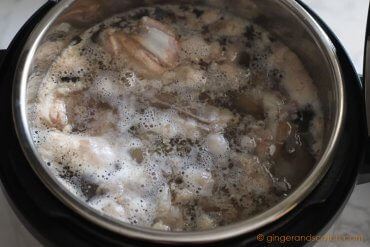
- Pressure Cook Bones for 3 hours: Clean your Instant Pot liner to remove all the impurities that have gathered on the bottom and sides. Rinse the bones under running water and place back into the cleaned liner. Add all remaining stock ingredients except for the chicken. Pour water to max line. Set Instant Pot to Pressure Cook at High Pressure for 3 hours and be sure to turn OFF the "Keep Warm" function. When the 3 hours are complete, allow the pressure to release naturally (could take up to an hour). If you Quick Release by pressing the spout then a lot of gunk will spurt out and make a mess of your Instant Pot and kitchen.

- Saute Bones for 1 to 2 hours: When pressure has released, remove lid and add chicken to the pork bones. Saute on high for 1 to 2 hours. This rapid boil releases the collagen from the bones and turns the stock white-ish.
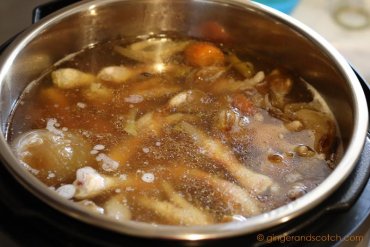
- Strain Stock and Refrigerate: Strain the stock into large pot or container and discard the strained solids. You should have 1 quart of stock.Allow stock to cool at room temperature for about 1 hour and then cover and place in refrigerator to overnight.
- Discard Solidified Fat but Reserve a Few Tablespoons: Remove stock from fridge. You will see that the pork stock has turned into a nice jelly with the pork fat sitting on the very top. Using a large spoon, gently scoop the pork fat out and discard BUT save a few tablespoons of this fat in a bowl for the final plating. If not using immediately, cover reserved fat and place in fridge. Note: do not discard the fat in your sink or it may clog your drain.Return tonkotsu stock to fridge until ready to serve.
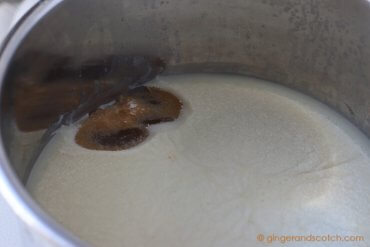
(2) Dashi3
- Soak Kombu: While the tonkotsu stock is pressure cooking, make the dashi by soaking the kombu in a pot of room temperature water for 30 minutes.
- Simmer Kombu: After soaking, bring the pot to a boil and simmer the kombu for 10 minutes (uncovered). After 10 minutes, turn off the heat and remove the dashi and either discard the kombu or save for making a secondary dashi stock (which is perfect for miso soup).
- Add katsuobushi and Steep: Add the katsuobushi (bonito flakes) and allow to steep for 10 minutes.
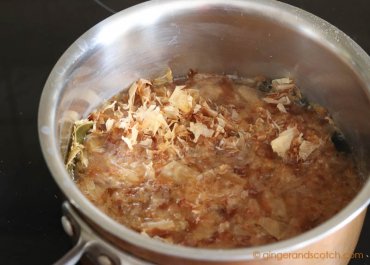
- Strain Dashi: Strain the dashi liquid using a fine mesh sieve. Discard the katsuobushi or you can save it for making a secondary dashi.
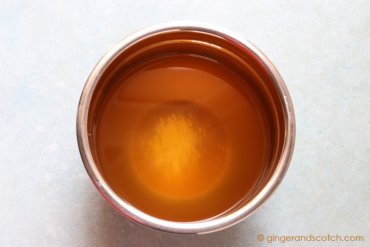
(3) Tare:
- Mix all ingredients in saucepan and heat on high until it comes to a boil. Remove from heat.
- Use this tare to marinade the pork belly and ramen eggs.
(5) Instant Pot Ramen Eggs:
- Pressure Cook Eggs: Eggs should be at room temperature1. Place eggs in instant pot on a trivet or in a steaming basket and pour in 1 cup of water. Pressure cook on High for 6 minutes with Quick Release (QR).
- Cool, Peel and Marinade Eggs: After QR, Immediately submerge eggs in a bowl of cold/ice water to stop the cooking process. When eggs are cool (about 5 minutes), peel and place peeled eggs gently in a container. with 1/4 cup tare and 3/4 cup water. Cover and refrigerate overnight. Remove eggs from marinade (DO NOT discard marinade) and set aside until final plating. You can add this used marinade to the pork belly simmering liquid below.

(4) Pork Belly:
- Marinade Pork: Place pork belly in a gallon-sized resealable bag. Add 1/4-cup tare into the bag, seal and place in fridge overnight. Turn the bag every once in a while to evenly distribute the marinade.

- Simmer Pork: The next day, place pork belly along with its marinade in a pot with lid. Also add the marinade that was used in the ramen eggs.Bring to a boil then lower heat and simmer for 1 hour. The pork should be beautifully tender at that point.
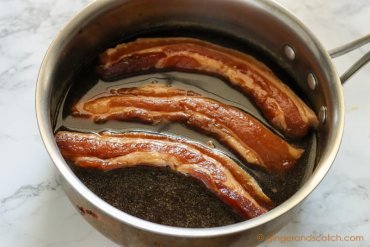
- Cool and Slice Pork: Remove pork from the pot and place on a plate to cool at room temperature or in the refrigerator. Cooling makes slicing easier otherwise the meat will tear. DO NOT DISCARD THE MARINADE. Strain the marinade into a bowl, cover and store in the fridge to use for the final plating. When the pork is cool (about 1 hour), slice into 1/4 inch slices. The pork belly is easier to cut when cooled. Cover and refrigerate.

- Note: If you have excess pork belly fat then you can make a topping out of it.This is optional but adds a nice, rich flavor to the final dish. See TOPPINGS section below for instructions.
(6) Prepare Toppings:
- Toast Sesame Seeds: Sesame seeds will taste much better if you toast them. Do this as close to plating time as possible to retain the toasted flavor. Heat a small frying pan to medium-high heat. Add sesame seeds and swirl the pan every 10-15 seconds for 3-5 minutes or until the seeds have darkened in color slightly. Remove from heat and set aside. You'll need 1/2 teaspoon per bowl or ramen.
- Pork Belly Fat: Before marinading the pork belly, cut off the skin (and discard) and reserve any excess fat. Cut pork belly fat into little pieces about 1/4-inch squares. To a small frying pan, add enough oil to barely cover the bottom of the pan and heat it up on medium heat. When the oil is hot, gently add to the pork to the oil. Fry while stirring until pork belly is nicely browned and crunchy.You'll need 1 teaspoon per bowl of ramen.

- Skimmed Pork Fat: This is the fat that was scooped up from the jellified stock and saved. You'll need 2 teaspoons per bowl of ramen.
- Corn: If using fresh corn still on the cob, then steam the corn until cooked, about 10-15 minutes. Cool and use a knife to cut the kernels off the cob. You can also use canned corn.You'll need 1 tablespoon per bowl of ramen.
- Green onions: Thinly slice the green part of the scallions.You'll need 1-2 tablespoons per bowl of ramen.
(6) Ramen Noodles:
- Make Ramen Noodles: If using pre-packaged noodles, boil according to the package instructions. Drain.If making your own, then click here for the recipe. Note that 1 recipe of ramen noodles only makes enough for 4 servings. So for 6 servings, you will need 1.5 recipe portions or 3 cups (360 grams) of flour.Make the noodles according to the recipe directions, cook, drain and rinse under cold water to stop cooking process. Drain well. When ready to serve, quickly dunk noodles in boiling water to reheat5. Divide into 6 bowls.
(7) Final Plating:
- Combine Pork Stock with Dashi: When you are ready to plate the ramen, heat up tonkotsu stock to a simmer, add dashi. You should have a total of 2 quarts of stock.
- Get Toppings Ready: Line up all your toppings ready to be doled out atop each serving bowl. Pork belly, ramen eggs, sesame seeds, pork belly fat, chasu tare and green onions, etc.
- Add Chasu Tare: Spoon 1 to 2 tablespoons of chasu tare in each serving bowl. Optional: Spoon 1 teaspoon skimmed pork fat in each serving bowl.
- Heat noodles4: Using a spider strainer, put one portion of noodles in the strainer and dunk it in the broth for a few seconds to warm up the noodles. Then place hot noodles in a serving bowl. Repeat for each serving.
- Assemble Bowls: Pour hot broth over each bowl. Assemble toppings and serve. Enjoy!
Notes
1 For Pork bones, I use pig trotters but if unavailable, I will get whatever pork bones I can find.
2 Chicken will not fit in at the beginning so we will add it at the end of the pressure cycle when sauteing on high.
3 Dashi - If you cannot get the ingredients to make dashi, you can buy dashi granules ("hondashi").
4 Noodles - I have been known to microwave the noodles for 45 to 60 seconds for a quick reheat instead of dunking in boiling water/stock. Then divide among the serving bowls.
